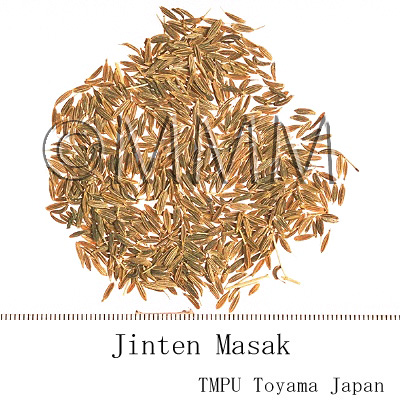Crude drug sample data base
※Click on the image to enlarge it.
Scientific information data base
| Crude drug name | Indonesian name, English name | Jinten putih, Cumin | ||||
|---|---|---|---|---|---|---|
| crude drug image |
| |||||
| Original plant name | Cuminum cyminum Linn. | |||||
| Family name | Umbelliferae | |||||
| Used part | Fruits | |||||
| Distribution area | Its origin is said to be from the south-eastern Mediterranean to central Asia. It is cultivated in China, India, Morocco, Cyprus, Egypt, Turkey, Iran, southern Russia. The plant is now cultivated occasionally in South-East Asia only in mountainous areas. It is also cultivated in the mountainous areas in Java (Indonesia) [201, 204]. | |||||
| Description | Fruits are ovoid-oblongoid, erect or slightly curved schizocarp, 3.5-6.5 mm x 1-2 mm x 0.8-1.5 mm, crowned by persistent, sharp stylopodia and sepal bases, yellow-brown; primary ribs 8, secondary ribs prominent and alternating with and wider than primary ones, whitish setose but bristles, breaking off easily; at slight pressure the fruit splits into 2 mericarps; mericarps strongly concave ventrally, convex dorsally. Seed with testa adnate to the fruit wall, endosperm grey, fatty. The plant is an annual herb, all green parts glabrous. Leaves alternate, compound, blue-green [204]. Cumin has strong odour, warm, pungent and persistent [204]. | |||||
| Drug effect | Warming, pungent [204]. | |||||
| Specific actions | Carminative [231]. | |||||
| Frequency in use | Moderate. | |||||
| Common uses | Small amount of fruits are for culinary use to flavour dishes (soup, meat, salad dressings etc.). | |||||
| Pharmacological effect | Study on the role of C. cyminum supplementation to diabetic rats resulted in a significant reduction in blood glucose, increase in total haemoglobin, prevented a decrease in total body weight, significant reduction in plasma and tissue cholesterol, phospholipids, free fatty acids and triglycerides [PMID:12220968]. An antibacterial activity of essential oil of C. cyminum against the genera Clavibacter, Curtobacterium, Rhodococcus, Erwinia, Xanthomonas, Ralstonia, and Agrobacterium with agar diffusion method showed a high activity. A lower activity was observed against bacteria belonging to the genus Pseudomonas [PMID:15631509]. The essential oil at the doses ranging between 0.0125 and 0.20 ml/kg exhibited a significant and dose-dependent analgesic effect in the model of chronic and inflammatory pain; no analgesic effect in tail flick test as a model of acute pain and was devoid of anti-inflammatory activity. It has low toxicity [Iran. Biomed. J.]. A significant inhibition of stomach tumor burden (tumors per mouse) by cumin was reported on the evaluation of the cancer chemopreventive potentials of different doses of a cumin seed-mixed diet against benzo(a)pyrene [B(a)P]-induced forestomach tumorigenesis and 3-methylcholanthrene (MCA)-induced uterine cervix tumorigenesis. The results strongly suggest the cancer chemopreventive potentials of cumin seed could be attributed to its ability to modulate carcinogen metabolism [PMID:15087270]. | |||||
| Medical system | Indonesian medicine (Jamu) | |||||
| Traditional usage | The fruit and the essential oil obtained from it are applied as a carminative [231]. | |||||
| Formulation | 1) Irregular menstruation: - Ingredients: 1 teaspoon of cumin seed, 2 dried clove buds, 1/2 nutmeg fruit , 1 turmeric rhizome, 1 cardamom fruit, 1 tablespoon of sugar, brown sugar, 2 pieces of Nyctanthes arbor-tristis leaves. - Preparation: All ingredients are mixed and boiled with 2 1/2 glasses of water to make a decoction. Drink the decoction for 5 days prior to the date of menstruation period. | |||||
| References | Reference book Tips! | [201] K. Heyne, Tumbuhan Berguna Indonesia, Vols. 1-4, 1987. Diedarkan Oleh Koperasi Karyawan Departemen Kehutanan, Jakarta, Indonesia. Vol. 3, p 1547. [204] de Guzman, C.C. and Siemonsma, J.S. (Editors), 1999. Plant Resources of South-East Asia No. 13 Species. Backhuys Publishers, Leiden, Netherlands. pp 108-111. [231] Soedibyo, Mooryati: Alam Sumber Kesehatan: Manfaat dan Kegunaan (Natural resources for health. Benefits and uses). Balai Pustaka. 1998. pp 178-179. | ||||
| Research paper | 1. Iacobellis NS, Lo Cantore P, Capasso F, Senatore F. Antibacterial activity of Cuminum cyminum L. and Carum carvi L. essential oils. J Agric Food Chem. 12;53(1):57-61, 2005. (PMID: 15631509) 2. Gagandeep, Dhanalakshmi S, Mendiz E, Rao AR, Kale RK. Chemopreventive effects of Cuminum cyminum in chemically induced forestomach and uterine cervix tumors in murine model systems. Nutr Cancer. 47(2):171-80, 2003. (PMID: 15087270) 3. Yan JH, Tang KW, Zhong M, Deng NH. Determination of chemical components of volatile oil from Cuminum cyminum L. by gas chromatography-mass spectrometry. Se Pu. 20(6):569-72, 2002. (PMID: 12683011) 4. Dhandapani S, Subramanian VR, Rajagopal S, Namasivayam N. Hypolipidemic effect of Cuminum cyminum L. on alloxan-induced diabetic rats. Pharmacol Res. 46(3):251-5, 2002. (PMID: 12220968) 6. Mohammad Sayyah, Afshin Peirovi and Mohammad Kamalinejad Anti-Nociceptive effect of the fruit essential oil of Cuminum cyminum L. in rat. Iran.Biomed.J. 6(4):141-145, 2002. | |||||
| Last renewal date | 2024/03/05 | |||||





